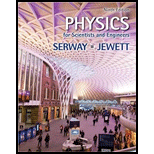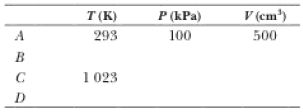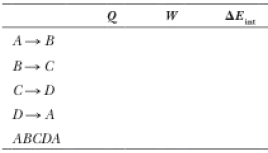
The compression ratio of an Otto cycle as shown in Figure 21.12 is VA/VB = 8.00. At the beginning A of the compression process, 500 cm3 of gas is at 100 kPa and 20.0°C. At the beginning of the adiabatic expansion, the temperature is TC = 750°C. Model the working fluid as an ideal gas with γ = 1.40. (a) Fill in this table to follow the states of the gas:

(b) Fill in this table to follow the processes:

(c) Identify the energy input |Qh|, (d) the energy exhaust |Qc|, and (e) the net output work Weng. (f) Calculate the efficiency. (g) Find the number of crankshaft revolutions per minute required for a one-cylinder engine to have an output power of 1.00 kW = 1.34 hp. Note: The
(a)
The states of the gas during the Otto cycle.
Answer to Problem 22.82CP
The complete table is shown below.
| State | |||
| A | 293 | 100 | 500 |
| B | 673 | 62.5 | |
| C | 1023 | 62.5 | |
| D | 445 | 152 | 500 |
Explanation of Solution
The compression ratio of an Otto cycle is
In Otto cycle, the process
Write the expression to calculate the quantity of the gas.
Here,
Substitute
In process
Write the expression to calculate the pressure at point B.
Here,
Substitute
Write the expression for the compression ratio
Substitute
Write the expression to calculate the temperature at point B.
Substitute
At state C:
Here,
Write the expression to calculate the pressure at point C.
Here,
Substitute
State D:
Here,
Therefore, the compression ratio
Write the expression to calculate the pressure at point D.
Here,
Substitute
Write the expression to calculate the temperature at point D.
Substitute
From the above explanation, the complete table is given below.
| State | |||
| A | 293 | 100 | 500 |
| B | 673 | 62.5 | |
| C | 1023 | 62.5 | |
| D | 445 | 152 | 500 |
Conclusion:
Therefore, the complete table is given below.
| State | |||
| A | 293 | 100 | 500 |
| B | 673 | 62.5 | |
| C | 1023 | 62.5 | |
| D | 445 | 152 | 500 |
(b)
The heat transferred, work done and the change in internal energy during the different process in the Otto cycle.
Answer to Problem 22.82CP
The complete table is shown below.
| Process | Q | ||
| 0 | -162 | 162 | |
| 149 | 0 | 149 | |
| 0 | 246 | -246 | |
| -65 | 0 | -65 | |
| 84.3 | 84.3 | 0 |
Explanation of Solution
The process
Let
Write the expression for change in internal energy in A to B process.
Substitute
Write the expression of first law of thermodynamics.
Substitute
Write the expression to calculate the energy in B to C process.
Substitute
Write the expression of first law of thermodynamics.
Substitute
Write the expression to calculate the energy in C to D process.
Substitute
Write the expression of first law of thermodynamics.
Substitute
Write the expression to calculate the energy in D to A process.
Substitute
Write the expression of first law of thermodynamics.
Substitute
Add all the work done found above to find the net work done
Add the heat energy transferred in the four process given above to find the net heat energy
The change in internal energy during a cyclic process is zero.
Thus,
From the above explanation, the complete table is given below.
| Process | Q | ||
| 0 | -162 | 162 | |
| 149 | 0 | 149 | |
| 0 | 246 | -246 | |
| -65 | 0 | -65 | |
| 84.3 | 84.3 | 0 |
Conclusion:
Therefore, the complete table
| Process | Q | ||
| 0 | -162 | 162 | |
| 149 | 0 | 149 | |
| 0 | 246 | -246 | |
| -65 | 0 | -65 | |
| 84.3 | 84.3 | 0 |
(c)
The heat input during
Answer to Problem 22.82CP
The heat input during
Explanation of Solution
From part (b), the heat input during
Thus, the heat input during
Conclusion:
Therefore, the heat input during
(d)
The heat exhaust during
Answer to Problem 22.82CP
The heat exhaust during
Explanation of Solution
From part (b)
The heat exhaust during
Thus, the heat exhaust during
Conclusion:
Therefore, the heat exhaust during
(e)
The net work output.
Answer to Problem 22.82CP
The net work output is
Explanation of Solution
From part (b)
The net work output is
Thus, the net work output is
Conclusion:
Therefore, the net work output is
(f)
The thermal efficiency.
Answer to Problem 22.82CP
The thermal efficiency is
Explanation of Solution
Write the expression to calculate the thermal efficiency.
Conclusion:
Substitute
Therefore, the thermal efficiency is
(g)
The number of crankshaft revolution per minute.
Answer to Problem 22.82CP
The number of crankshaft revolution per minute is
Explanation of Solution
Write the expression to calculate the output power.
Here,
Substitute
Thus, the number of crankshaft revolution per minute is
Want to see more full solutions like this?
Chapter 22 Solutions
PHYSICS 1250 PACKAGE >CI<
- Suppose a toy boat moves in a pool at at a speed given by v=1.0 meter per second at t=0, and that the boat is subject to viscous damping. The damping on the boat causes the rate of speed loss to be given by the expression dv/dt=-2v. How fast will the boat be traveling after 1 second? 3 seconds? 10 seconds? Use separation of variables to solve this.arrow_forwardWhat functional form do you expect to describe the motion of a vibrating membrane without damping and why?arrow_forwardIf speed is tripled, how much larger will air drag become for an object? Show the math.arrow_forward
- What does it tell us about factors on which air drag depends if it is proportional to speed squared?arrow_forwardWhat is the net charge on a sphere that has the following? x (a) 5.75 × 106 electrons and 8.49 × 106 protons 4.39e-13 What is the charge of an electron? What is the charge of a proton? C (b) 200 electrons and 109 protons 1.60e-10 What is the charge of an electron? What is the charge of a proton? Carrow_forwardA spider begins to spin a web by first hanging from a ceiling by his fine, silk fiber. He has a mass of 0.025 kg and a charge of 3.5 μC. A second spider with a charge of 4.2 μC rests in her own web exactly 2.1 m vertically below the first spider. (a) What is the magnitude of the electric field due to the charge on the second spider at the position of the first spider? 8.57e3 N/C (b) What is the tension in the silk fiber above the first spider? 0.125 How does the electric field relate to the force? How do you calculate the net force? Narrow_forward
- Point charges of 6.50 μC and -2.50 μC are placed 0.300 m apart. (Assume the negative charge is located to the right of the positive charge. Include the sign of the value in your answers.) (a) Where can a third charge be placed so that the net force on it is zero? 0.49 m to the right of the -2.50 μC charge (b) What if both charges are positive? 0.185 xm to the right of the 2.50 μC chargearrow_forwardc = ad Find the electric field at the location of q, in the figure below, given that q₁ = 9₁ = 9₁ = +4.60 nC, q=-1.00 nC, and the square is 20.0 cm on a side. (The +x axis is directed to the right.) magnitude direction N/C ° counterclockwise from the +x-axis 9a % 9 9barrow_forwardPlastic beads can often carry a small charge and therefore can generate electric fields. Three beads are oriented such that 92 is between q₁ and 93. The sum of the charge on 9₁ and 92 is 9₁ + 92 = −2.9 µС, and the net charge of the system of all three beads is zero. E field lines 93 92 What charge does each bead carry? 91 92 -1.45 What is the net charge of the system? What charges have to be equal? μC 2.9 ✓ What is the net charge of the system? What charges have to be equal? μC 93 2.9 μεarrow_forward
- A spider begins to spin a web by first hanging from a ceiling by his fine, silk fiber. He has a mass of 0.025 kg and a charge of 3.5 μC. A second spider with a charge of 4.2 μC rests in her own web exactly 2.1 m vertically below the first spider. (a) What is the magnitude of the electric field due to the charge on the second spider at the position of the first spider? 8.57e3 N/C (b) What is the tension in the silk fiber above the first spider? 0.275 How does the electric field relate to the force? How do you calculate the net force? Narrow_forwardPlastic beads can often carry a small charge and therefore can generate electric fields. Three beads are oriented such that 92 is between 91 system of all three beads is zero. E field lines 91 92 93 X What charge does each bead carry? 91 = 92 = ?2.9 0 μC × What is the net charge of the system? What charges have to be equal? μC 93 2.9 με and 93. The sum of the charge on 91 and 92 is 91 +92 = -2.9 μC, and the net charge of thearrow_forwardAn electron has an initial speed of 5.26 x 100 m/s in a uniform 5.73 x 105 N/C strength electric field. The field accelerates the electron in the direction opposite to its initial velocity. (a) What is the direction of the electric field? opposite direction to the electron's initial velocity same direction as the electron's initial velocity not enough information to decide × What is the direction of the force on the electron? How does it compare to the direction of the electric field, considering the sign of the electron's charge? (b) How far does the electron travel before coming to rest? 0.0781 × What kinematic equation is relevant here? How do you calculate the force due to the electric field? m (c) How long does it take the electron to come to rest? 5.27e8 What is the final velocity of the electron? s (d) What is the electron's speed when it returns to its starting point? 5.26e6 m/sarrow_forward
 Physics for Scientists and EngineersPhysicsISBN:9781337553278Author:Raymond A. Serway, John W. JewettPublisher:Cengage Learning
Physics for Scientists and EngineersPhysicsISBN:9781337553278Author:Raymond A. Serway, John W. JewettPublisher:Cengage Learning Physics for Scientists and Engineers with Modern ...PhysicsISBN:9781337553292Author:Raymond A. Serway, John W. JewettPublisher:Cengage Learning
Physics for Scientists and Engineers with Modern ...PhysicsISBN:9781337553292Author:Raymond A. Serway, John W. JewettPublisher:Cengage Learning Physics for Scientists and Engineers: Foundations...PhysicsISBN:9781133939146Author:Katz, Debora M.Publisher:Cengage Learning
Physics for Scientists and Engineers: Foundations...PhysicsISBN:9781133939146Author:Katz, Debora M.Publisher:Cengage Learning Principles of Physics: A Calculus-Based TextPhysicsISBN:9781133104261Author:Raymond A. Serway, John W. JewettPublisher:Cengage Learning
Principles of Physics: A Calculus-Based TextPhysicsISBN:9781133104261Author:Raymond A. Serway, John W. JewettPublisher:Cengage Learning Physics for Scientists and Engineers, Technology ...PhysicsISBN:9781305116399Author:Raymond A. Serway, John W. JewettPublisher:Cengage Learning
Physics for Scientists and Engineers, Technology ...PhysicsISBN:9781305116399Author:Raymond A. Serway, John W. JewettPublisher:Cengage Learning





